Broadcom BRCM1075 802.11abgn/ac WLAN+Bluetooth4.0 NGFF2230 Mini Card User Manual Edge 15 User Guide
Broadcom Corporation 802.11abgn/ac WLAN+Bluetooth4.0 NGFF2230 Mini Card Edge 15 User Guide
Broadcom >
Contents
User Manual 1
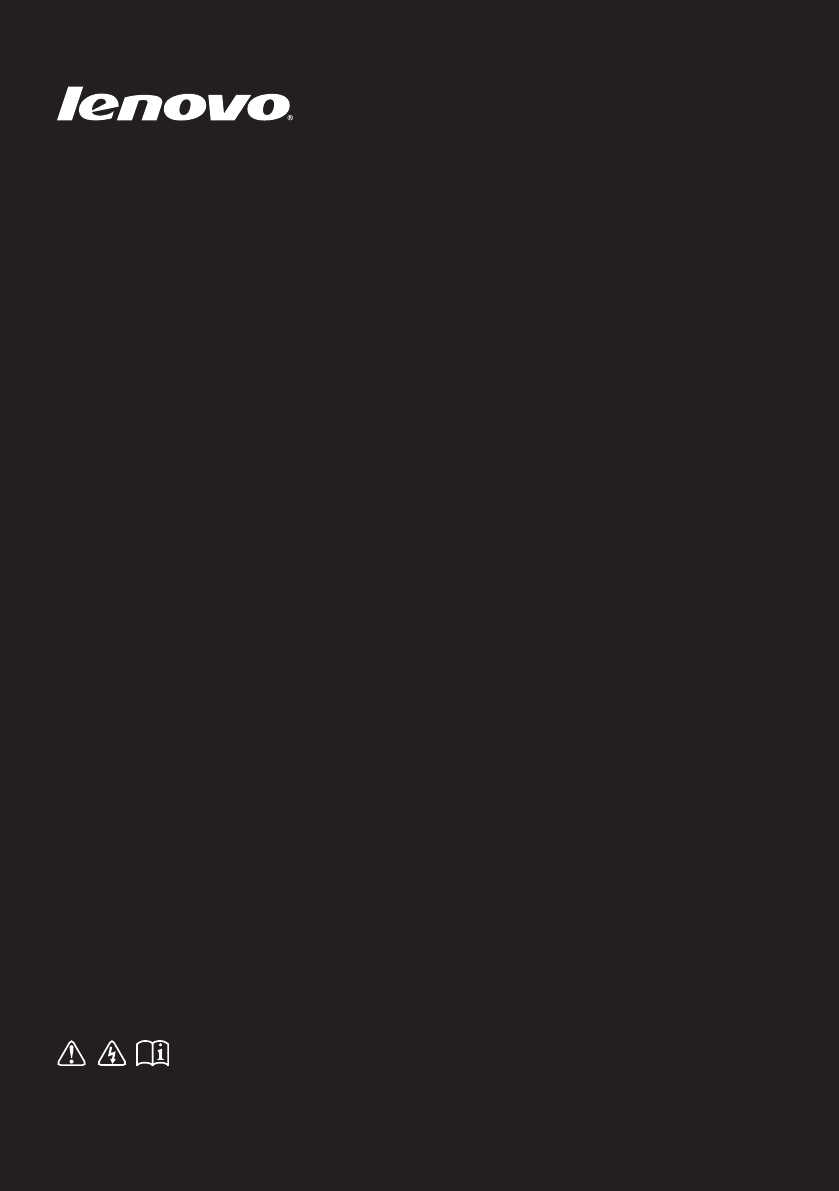
Lenovo
Edge 15
Read the safety notices and important tips in the
included manuals before using your computer.
en-US
Rev. AA00
User Guide

First Edition (April 2014)
© Copyright Lenovo 2014.
Before using the product, be sure to read Lenovo Safety and General
Information Guide first.
The features described in this guide are common to most models.
Some features may not be available on your computer and/or your
computer may include features that are not described in this user
guide.
Some instructions in this guide may assume that you are using
Windows® 8.1. If you are using other Windows operating systems,
some operations may be slightly different. If you are using other
operating systems, some operations may not apply to you.
LIMITED AND RESTRICTED RIGHTS NOTICE: If data or software is delivered pursuant a General
Services Administration “GSA” contract, use, reproduction, or disclosure is subject to restrictions set
forth in Contract No. GS-35F-05925.
Notes
•
•
•
The illustrations in this manual may differ from the actual product.
Please refer to the actual product.
•
The illustrations used in this manual are from Lenovo Edge 15
unless otherwise stated.
•
For details, refer to Guides & Manuals at http://support.lenovo.com.
Regulatory Notice
•
i
Chapter 1. Getting to know your computer ..........................................1
Topview.......................................................................................................................1
Left‐sideview ..............................................................................................................7
Right‐sideview............................................................................................................9
Bottomview ...............................................................................................................13
Chapter 2. Starting to use Windows 8.1 .............................................14
Configuringtheoperatingsystemforthefirsttime ............................................14
Operatingsysteminterfaces ....................................................................................14
Thecharms .................................................................................................................15
Puttingthecomputertosleeporshuttingit
down ...........................................................................................................................17
Touchscreenoperation ............................................................................................20
Connectingtoawirelessnetwork ..........................................................................24
Helpandsupport ......................................................................................................25
HowtosetupBIOSwheninstallingWindows7.................................................26
Chapter 3. Lenovo OneKey Recovery system ................................... 27
Chapter 4. Troubleshooting ................................................................. 29
Frequentlyaskedquestions .....................................................................................29
Troubleshooting ........................................................................................................32
Trademarks............................................................................................ 36
Contents
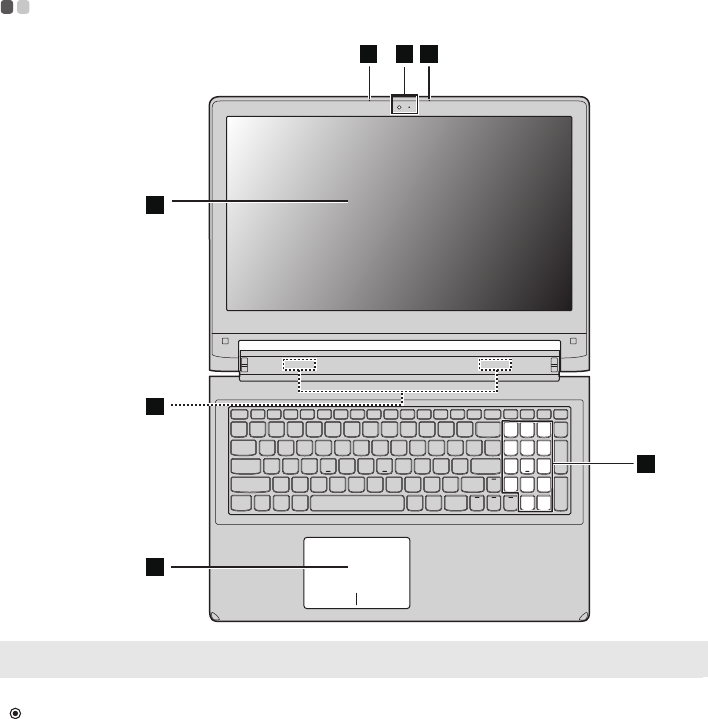
1
Chapter 1. Getting to know your computer
Top view - - - - - - - - - - - - - - - - - - - - - - - - - - - - - - - - - - - - - - - - - - - - - - - - - - - - - - - - - - - - - - - - - - - - - - - - - - - - - - - - - - - - - - - - - - - - - - - - - - - - -
Note: Thedashedareasindicatepartsthatareinvisiblefromoutside.
Attention:
•Donotopenthedisplaypanelbeyond300degrees.Whenclosingthedisplaypanel,be
carefulnottoleavepensoranyotherobjectsinbetweenthedisplaypanelandthe
keyboard.Otherwise,thedisplaypanelmaybedamaged.
1 2
4
5
6
2
3
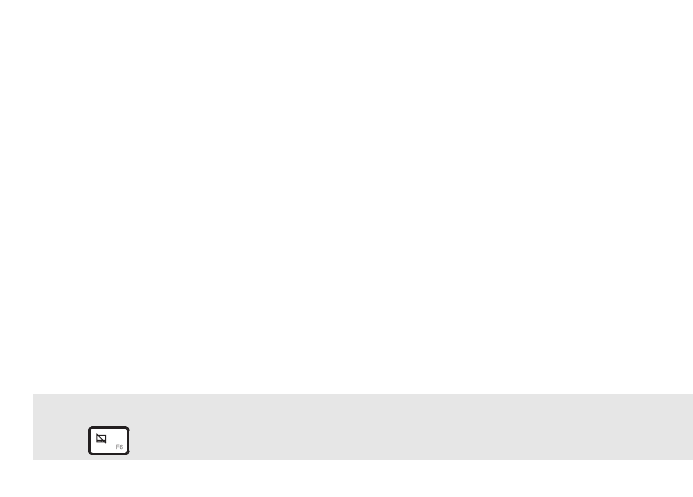
2
Chapter 1. Getting to know your computer
Integrated
camera
Usedforvideocommunicationortakingphotos.
Built-in
microphone
Capturessoundwhichcanbeusedforvideo
conferencing,voicenarration,oraudiorecording.
Display Providesvisualoutput.
Wireless
antennas
Connectstothewirelessadaptertoreceiveandsend
wirelessradiosignals.
Touch pad Thetouchpadfunctionsasaconventionalmouse.
Touchpad:Tomovethepointeronthescreen,slideyour
fingertiponthepadinthedirectionyouwishtomovethe
cursor.
Touchpadbuttons:Performthefunctionsoftheleftand
rightbuttonsasthoseoftheleftandrightbuttonsona
conventionalmouse.
Note: YoucanenableordisabletheTouchpadandtheTouchpadbuttonsbypressing
.
Numeric keypad Fordetails,see“Usingthekeyboard”onpage3.
a
b
c
d
e
f
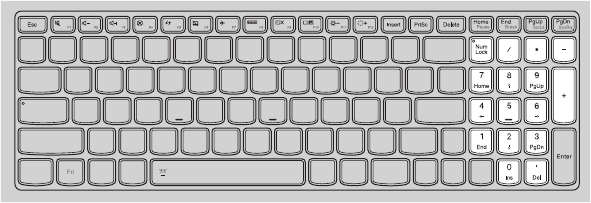
Chapter 1. Getting to know your computer
3
Using the keyboard
Yourcomputerhasanumerickeypad,hotkeys,andfunctionkeysincorpo‐
ratedintoitsstandardkeyboard.
Numeric keypad
Thekeyboardhasaseparatenumerickeypad.Toenableordisablethe
numerickeypad,presstheNumLockkey.
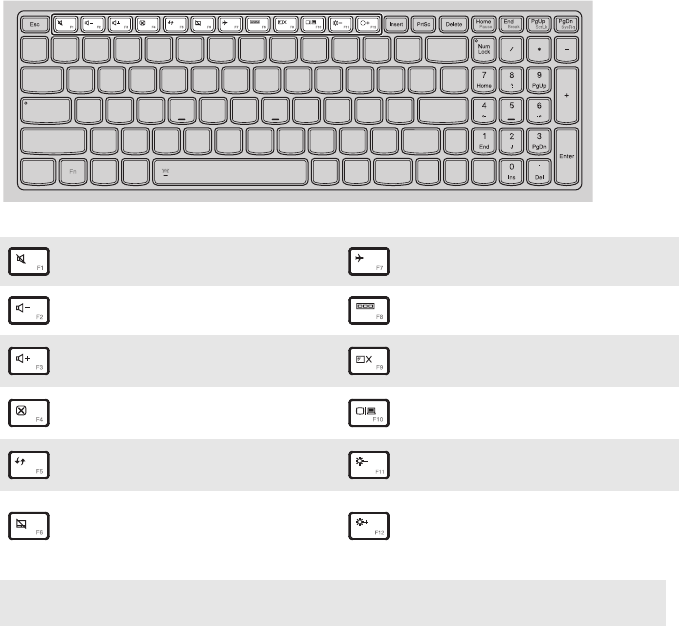
4
Chapter 1. Getting to know your computer
Hotkeys
Youcanaccesscertainsystemsettingsquicklybypressingtheappropriate
hotkeys.
: Mutes/unmutesthesound. : Enables/disablesairplanemode.
: Decreasesthevolumelevel. : Switchestheactiveprogram.
: Increasesthevolumelevel. : Turnson/offthebacklightofthe
display.
: Closesthecurrentlyactivewin‐
dow. : Projectstoaconnecteddisplay.
: Refreshesthedesktoporthecur‐
rentlyactivewindow. : Decreasesdisplaybrightness.
:
Enables/disablesthe
touchpadandthetouchpad
buttons. : Increasesdisplaybrightness.
Note: IfyouchangedtheHotkeyModefromEnabledtoDisabledintheBIOSsetuputility,
youwillneedtopresstheFnkeyincombinationwiththeappropriatehotkey.
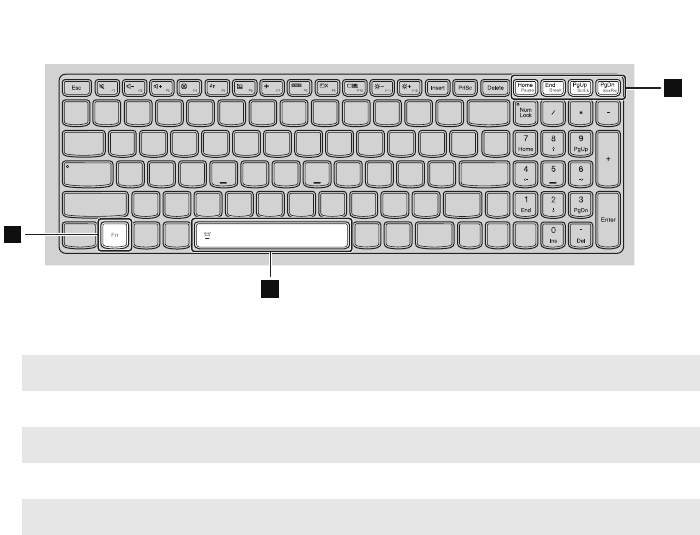
Chapter 1. Getting to know your computer
5
Function key combinations
Throughtheuseofthefunctionkeys,youcanchangeoperationalfeatures
instantly.Tousethisfunction,pressandholdFn;thenpressoneofthe
functionkeys.
Thefollowingdescribesthefeaturesofeachfunctionkey.
Fn + Home: Activatethepausefunction.
Fn + End: Activatethebreakfunction.
Fn + PgUp: Enable/Disablethescrolllock.
Fn + PgDn: Activatethesystemrequest.
Fn + Space: Turnon/offthekeyboardbacklight.
a
b
1
2
2
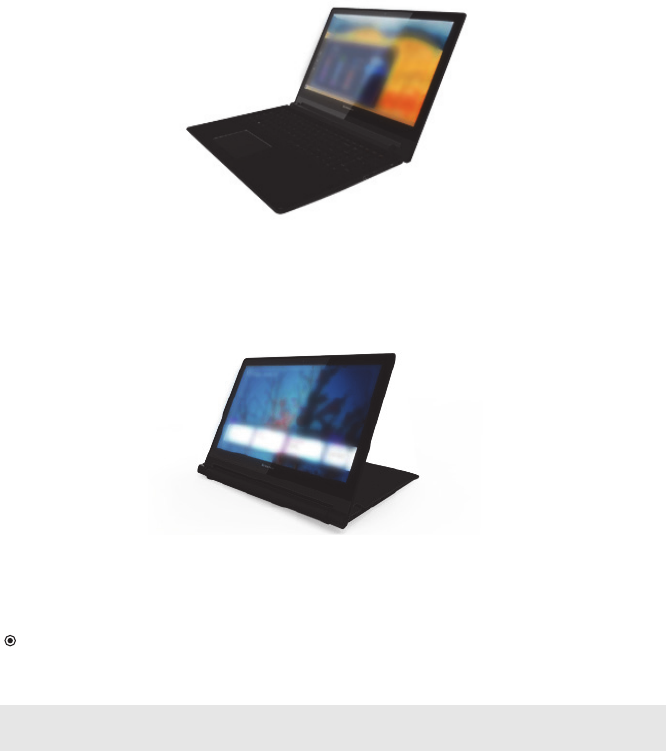
6
Chapter 1. Getting to know your computer
Positioning the display panel
Notebook Mode
Suitablefortasksthatrequireakeyboardandmouse(suchascreating
documents,writinge‐mails,andsoon).
Stand Mode (Theater Mode)
Suitablefortasksthatrequirelittleornotouch(suchasviewingphotosor
playingvideos).
Attention:
•Donotopenthedisplaywithtoomuchforce,otherwisethedisplaypanelorhingesmay
bedamaged.
Note: Thekeyboardandtouchpadareautomaticallylockedifthekeyboardpanelfaces
down.
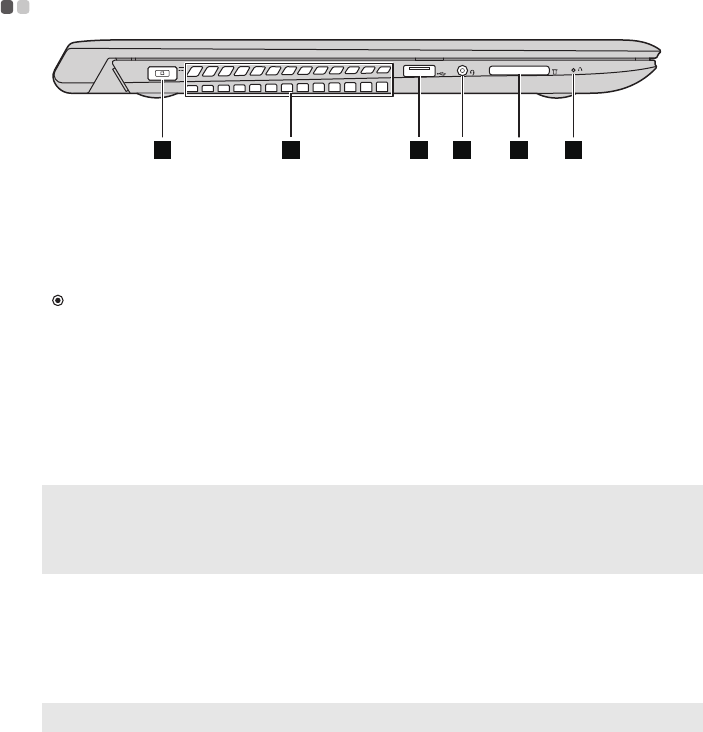
Chapter 1. Getting to know your computer
7
Left-side view - - - - - - - - - - - - - - - - - - - - - - - - - - - - - - - - - - - - - - - - - - - - - - - - - - - - - - - - - - - - - - - - - - - - - - - - - - - - - - - - - - - - - - - - - -
AC power
adapter jack
ConnectstheACpoweradapter.
Ventilation slots Dissipateinternalheat.
Attention:
•Makesurethatnoneoftheventilationslotsareblockedorelseoverheatingofthe
computermayoccur.
USB 2.0 port ConnectstoUSBdevices.Fordetails,see“Connecting
USBdevices”onpage8.
Combo audio
jack
Connectstoheadsets.
Notes:
•Thecomboaudiojackdoesnotsupportconventionalmicrophones.
•Therecordingfunctionmaynotbesupportedifthird‐partyheadphonesorheadsetsare
connected,duetodifferentindustrystandards.
Memory card slot Insertmemorycards(notsupplied)here.Fordetails,see
“Usingmemorycards(notsupplied)”onpage12.
Novo button Whenthecomputerisoff,pressthisbuttontostartthe
LenovoOneKeyRecoverysystemortheBIOSsetup
utility,ortoenterthebootmenu.
Note: Fordetails,see“Chapter3.LenovoOneKeyRecoverysystem”onpage27.
123 4 5 6
a
b
c
d
e
f
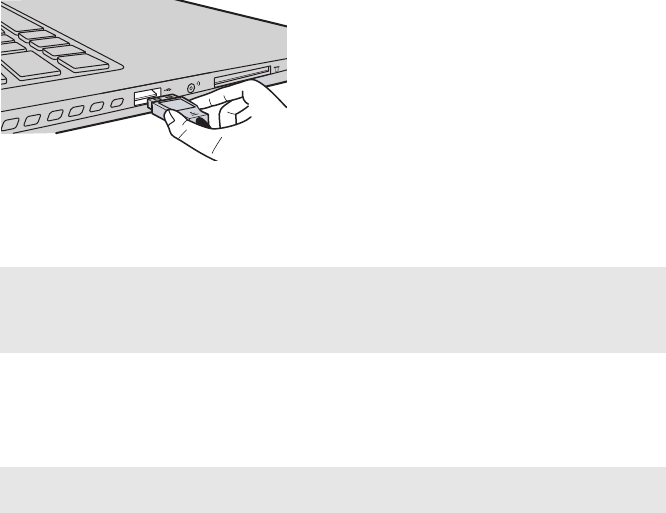
8
Chapter 1. Getting to know your computer
Connecting USB devices
YoucanconnectaUSBdevicetoyourcomputerbyinsertingitsUSBplug
(TypeA)intotheUSBportonyourcomputer.
ThefirsttimeyouplugaUSBdeviceintoaUSBportonyourcomputer,
Windowsautomaticallyinstallsadriverforthatdevice.Afterthedriveris
installed,youcandisconnectandreconnectthedevicewithoutperforming
anyadditionalsteps.
BeforedisconnectingaUSBstoragedevice,makesureyourcomputerhas
finishedtransferringdatabythatdevice.ClicktheSafelyRemoveHardware
andEjectMediaiconinthenotificationareaoftheWindowsdesktopscreen
toremovethedevicebeforedisconnecting.
Note: Typically,Windowsdetectsanewlyconnecteddeviceafterconnectingit,andthen
installsthedriverautomatically.However,somedevicesmayrequireyoutoinstallthe
driverbeforeconnecting.Checkthedocumentationprovidedbythemanufacturerof
thedevicebeforeconnecting.
Note: IfyourUSBdeviceusesapowercord,connectthedevicetoapowersourcebefore
connectingit.Otherwise,thedevicemaynotberecognized.
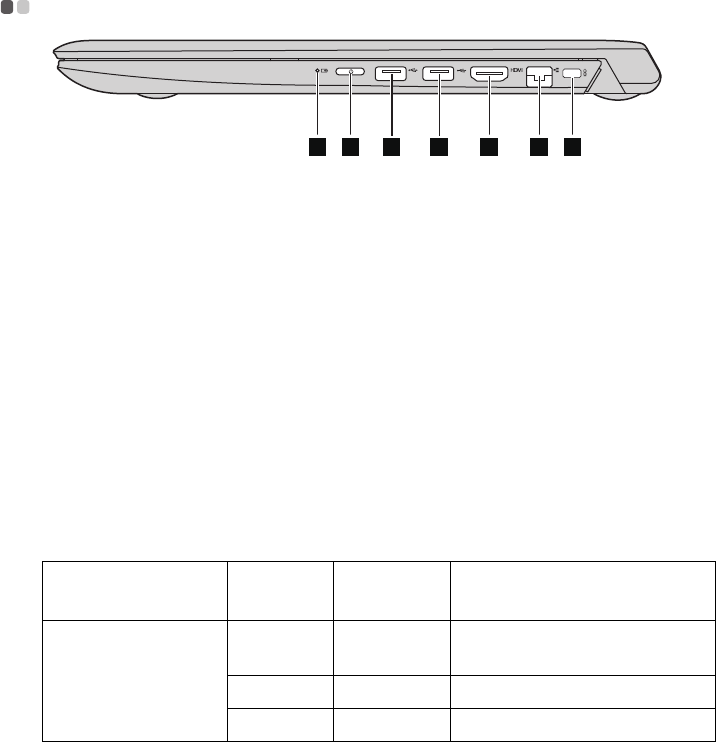
Chapter 1. Getting to know your computer
9
Right-side view - - - - - - - - - - - - - - - - - - - - - - - - - - - - - - - - - - - - - - - - - - - - - - - - - - - - - - - - - - - - - - - - - - - - - - - - - - - - - - - - - - - - - - -
Kensington slot Attachasecuritylock(notsupplied)heretohelpprotect
yourcomputerfromtheftandunauthorizeduse.
Youcanattachasecuritylocktoyourcomputertohelp
preventitfrombeingremovedwithoutyourpermission.
Fordetailsoninstallingthesecuritylock,pleasereferto
theinstructionsshippedwiththesecuritylockthatyou
havepurchased.
RJ-45 port ConnectsthecomputertoanEthernetnetwork.
HDMI port ConnectstodeviceswithHDMIinputsuchasaTVora
display.
USB 2.0 port ConnecttoUSBdevices.Fordetails,see“ConnectingUSB
devices”onpage8.
USB 3.0 port ConnecttoUSBdevices.Fordetails,see“ConnectingUSB
devices”onpage8.
Power button Pressthisbuttontoturnonthecomputer.
Indicator Indicator
status
Charge
Status
Meaning
Power status
indicator
On(solid
white)
—Thecomputerispoweredon.
Blinking —Thecomputerisinsleepmode.
Off —Thecomputerispoweredoff.
12467 3
5
a
b
c
d
e
b
f

10
Chapter 1. Getting to know your computer
Battery status
indicator
Indicator Indicator
status
Charge
Status
Meaning
Battery status
indicator
On(solid
white)
Discharging Thebatteryhasmorethan20%
charge.
Solid
amber
Discharging Thebatteryhasbetween5%
and20%charge.
Fast
blinking
amber
Charging/
Discharging
Thebatteryhaslessthan5%
charge.
Slow
blinking
amber
Charging Thebatteryisbeingcharged.
Whenbatterychargereaches
20%,theblinkingcolor
changestowhite.
Slow
blinking
white
Charging Thebatteryhasbetween20%
and80%chargeandisstill
charging.Whenthebattery
reaches80%chargethelight
willstopblinking,butcharg‐
ingwillcontinueuntilthebat‐
teryisfullycharged.
b
g
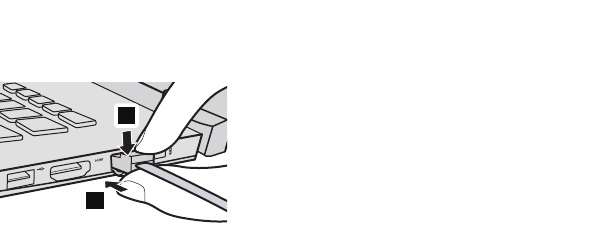
Chapter 1. Getting to know your computer
11
Connecting network cables
Toinsertanetworkcable,dothefollowing:
1
HoldtheconnectorofthenetworkcableandpushtheRJ‐45coverdown
inthedirectionbyarrow.
2
InserttheconnectorintotheRJ‐45portinthedirectionbyarrow.
Software configuration
ConsultyourInternetServiceProvider(ISP)fordetailsonhowtoconfigure
yourcomputer.
a
b
2
1

12
Chapter 1. Getting to know your computer
Using memory cards (not supplied)
Yourcomputersupportsthefollowingtypesofmemorycard:
•SecureDigital(SD)card
• MultiMediaCard(MMC)
Inserting a memory card
Slideamemorycardinuntilitclicksintoplace.
Removing a memory card
Gentlypullthememorycardoutofthememorycardslot.
Attention:
•Insertonlyonecardintheslotatatime.
•ThiscardreaderdoesnotsupportSDIOdevices(e.g.,SDIOBluetooth,etc.).
Note: Ifadummycardisshippedwiththecomputer,pushthedummycardandthen
removeitbeforeinsertingamemorycard.
Attention:
•Beforeremovingamemorycard,disableitthroughSafelyRemoveHardwareand
EjectMediatoavoiddatacorruption.
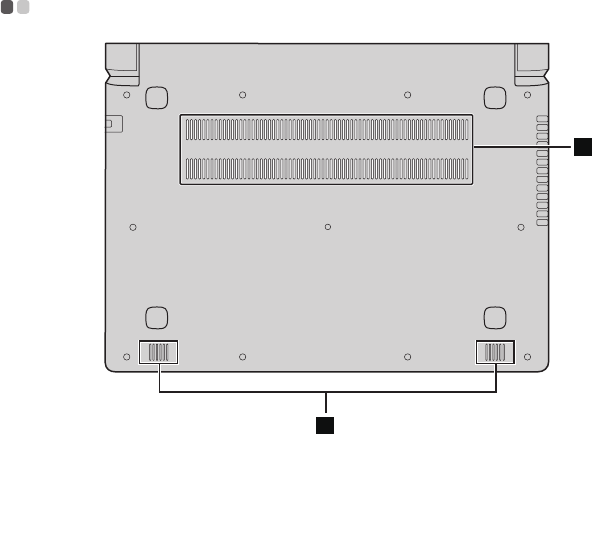
Chapter 1. Getting to know your computer
13
Bottom view - - - - - - - - - - - - - - - - - - - - - - - - - - - - - - - - - - - - - - - - - - - - - - - - - - - - - - - - - - - - - - - - - - - - - - - - - - - - - - - - - - - - - - - - - - - - -
Ventilation slots Allowairtoenterthecomputerforcooling.
Speakers Provideaudiooutput.
1
2
a
b
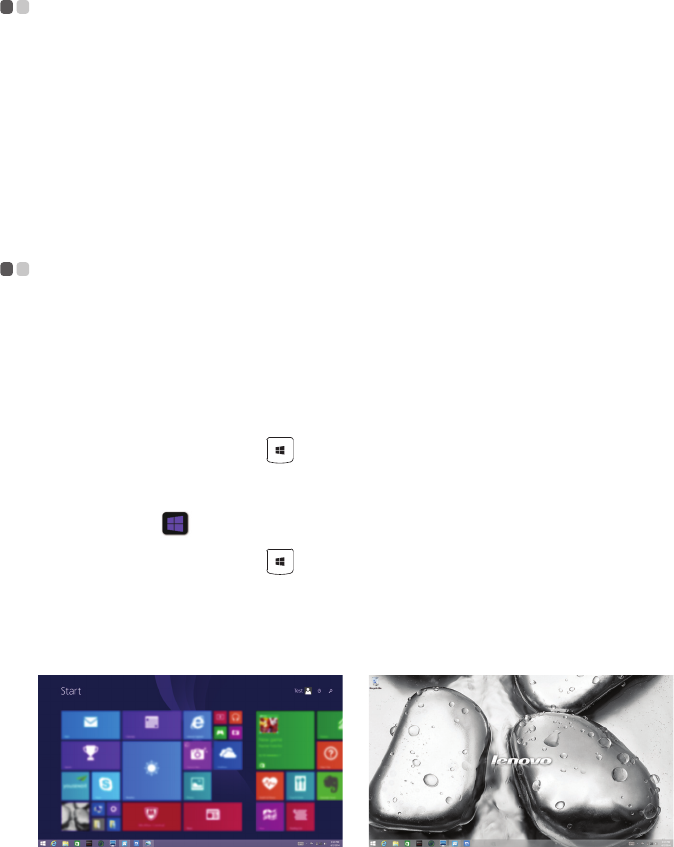
14
Chapter 2. Starting to use Windows 8.1
ThedefaultsystemofyourcomputerisWindows8.1.ToinstallWindows7
system,makesuretosetuptheBIOSfirst.AbouthowtosetupBIOS,see
“HowtosetupBIOSwheninstallingWindows7”onpage26.
Configuring the operating system for the first
time - - - - - - - - - - - - - - - - - - - - - - - - - - - - - - - - - - - - - - - - - - - - - - - - - - - - - - - - - - - - - - - - - - - - - - - - - - - - - - - - - - - - - - - - - - - - - - - - - - - - - - - - - - - - - -
Youmayneedtoconfiguretheoperatingsystemwhenitisfirstused.The
configurationprocessmayincludetheproceduresbelow:
• Acceptingtheenduserlicenseagreement
• ConfiguringtheInternetconnection
•Registeringtheoperatingsystem
• Creatingauseraccount
Operating system interfaces - - - - - - - - - - - - - - - - - - - - - - - - - - - - - - - - - - - - - - - - - - - - - - - - - -
Windows8.1comeswithtwomainuserinterfaces:theStartscreenandthe
Windowsdesktop.
To switch from the Start screen to the Windows desktop, do one of the
following:
•SelecttheWindowsdesktoptileontheStartscreen.
•PresstheWindowskey +D.
ToswitchfromthedesktoptotheStartscreen,dooneofthefollowing:
•SelectStart fromthecharmsbar.
•PresstheWindowskey.
•Movethecursortothelower‐leftcorner,andthenselecttheStartbutton.
Start screen Desktop
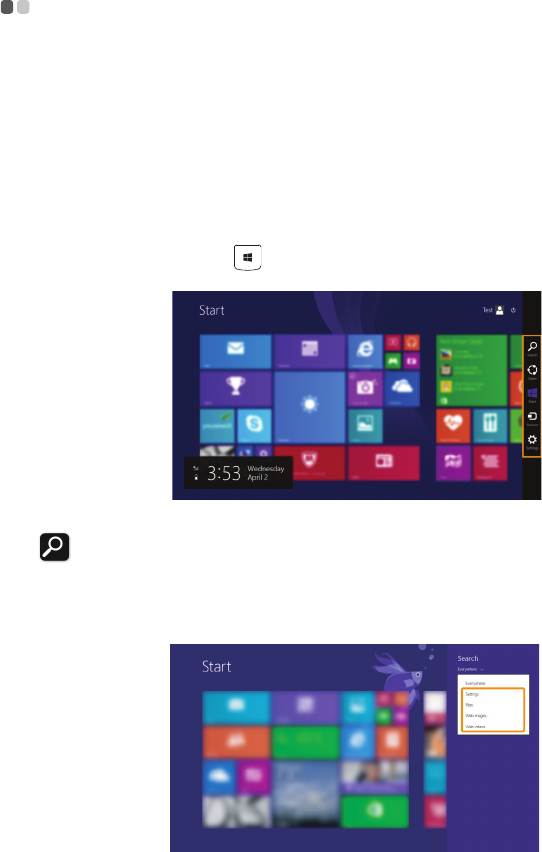
Chapter 2. Starting to use Windows 8.1
15
The charms - - - - - - - - - - - - - - - - - - - - - - - - - - - - - - - - - - - - - - - - - - - - - - - - - - - - - - - - - - - - - - - - - - - - - - - - - - - - - - - - - - - - - - - - - - - -
CharmsarenavigationbuttonsthatletyoucontrolyourWindows®8.1
experience.Charmsinclude:Search,Share,Start,Devices,andSettings.The
CharmsBaristhemenuthatcontainsthecharms.
Thefivecharmsprovidenewandfasterwaystoperformmanybasictasks,
andarealwaysavailableregardlessofwhicheverappyouarecurrentlyin.
To display the charms, do one of the following:
•Movethecursortotheupper‐rightorlower‐rightcorneruntilthecharms
barisdisplayed.
•PressWindowskey +C.
Search charm
TheSearchcharmisapowerfulnewwaytofindwhatyouarelookingfor,
includingsettings,files,Webimages,Webvideos,etc.
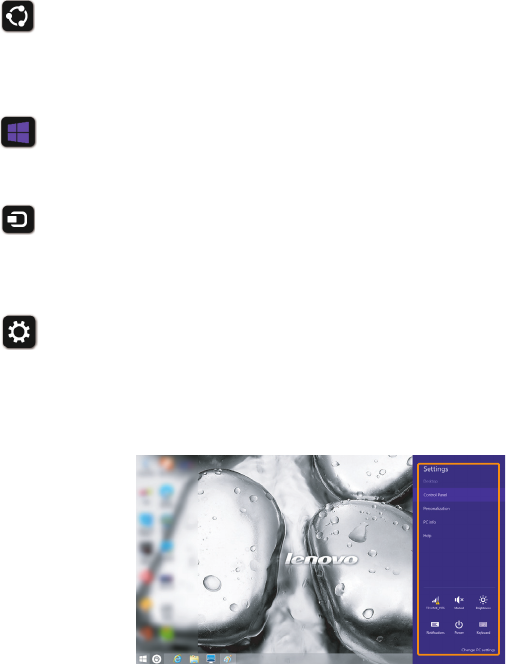
16
Chapter 2. Starting to use Windows 8.1
Share charm
TheSharecharmletsyousendlinks,photos,andmoretoyourfriendsand
socialnetworkswithoutleavingtheappyouarein.
Start charm
TheStartcharmisafastwaytogototheStartscreen.
Devices charm
TheDevicescharmallowsyoutoconnectorsendfilestoanyexternal
devices,includingthedevicestoplay,print,andproject.
Settings charm
TheSettingscharmletsyouperformbasictasks,suchassettingthevolume
orshuttingdownthecomputer.Also,youcangettotheControlPanel
throughtheSettingscharmwhenontheDesktopscreen.
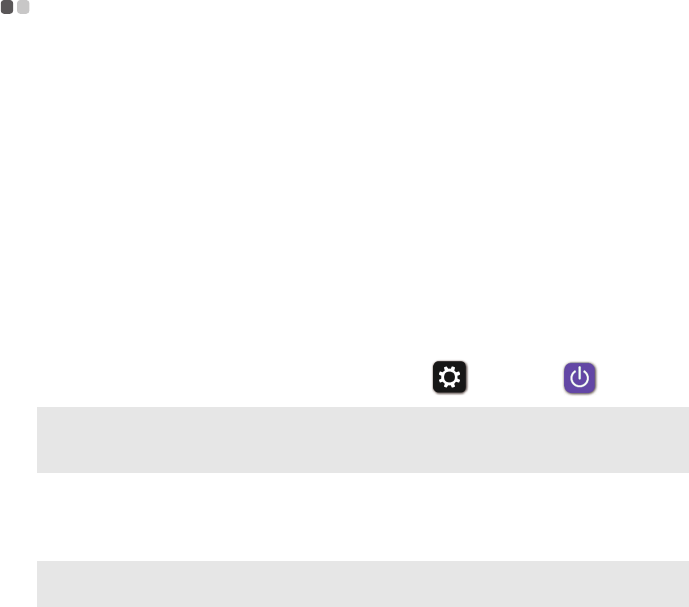
Chapter 2. Starting to use Windows 8.1
17
Putting the computer to sleep or shutting it
down - - - - - - - - - - - - - - - - - - - - - - - - - - - - - - - - - - - - - - - - - - - - - - - - - - - - - - - - - - - - - - - - - - - - - - - - - - - - - - - - - - - - - - - - - - - - - - - - - - - - - - - - - - - -
When you have finished working with your computer, you can put it to sleep
or shut it down.
Putting your computer to sleep
Ifyouwillbeawayfromyourcomputerforonlyashorttime,putthe
computertosleep.
When the computer is in sleep mode, you can quickly wake it to resume use,
bypassing the startup process.
Toputthecomputertosleep,dooneofthefollowing:
•Closethedisplaylid.
•Pressthepowerbutton.
•Openthecharms,andthenselectSettings Power Sleep.
Towakethecomputer,dooneofthefollowing:
•Pressanykeyonthekeyboard.
•Pressthepowerbutton.
Note: Waituntilthepowerindicatorlightstartsblinking(indicatingthatthecomputeris
insleepmode)beforeyoumoveyourcomputer.Movingyourcomputerwhilethe
harddiskisspinningcandamagetheharddisk,causinglossofdata.
Note: Ifthecomputerdoesnotawakenafterpressingakeyonthekeyboard,thismeans
thatthecomputerhasenteredanenhancedpower‐savingmode.
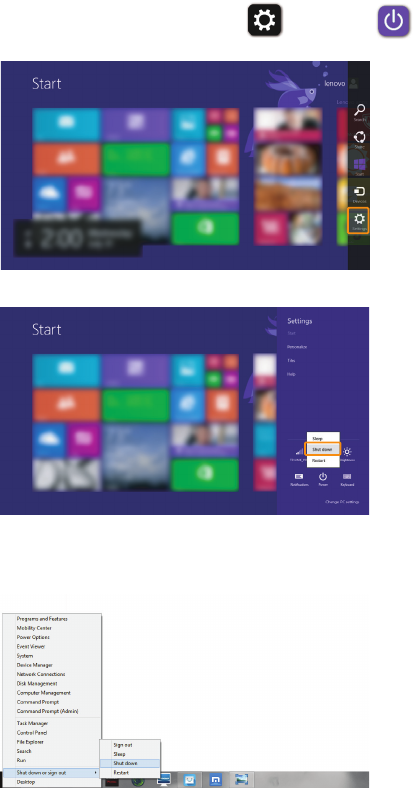
18
Chapter 2. Starting to use Windows 8.1
Shutting down the computer
Ifyouarenotgoingtouseyourcomputerforalongtime,shutitdown.
Toshutdownyourcomputer,dooneofthefollowing:
•OpenthecharmsbarandselectSettings Power Shutdown.
•Right‐clicktheStartbuttoninthelower‐leftcornerandselectShutdown
orsignoutShutdown.
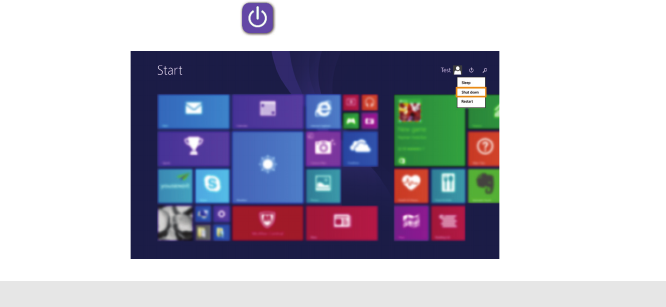
Chapter 2. Starting to use Windows 8.1
19
•OntheStartscreen,click andselectShutdown.
Note: ThisoperationdependsonyourBIOSsettings.Pleaserefertotheactualproduct.
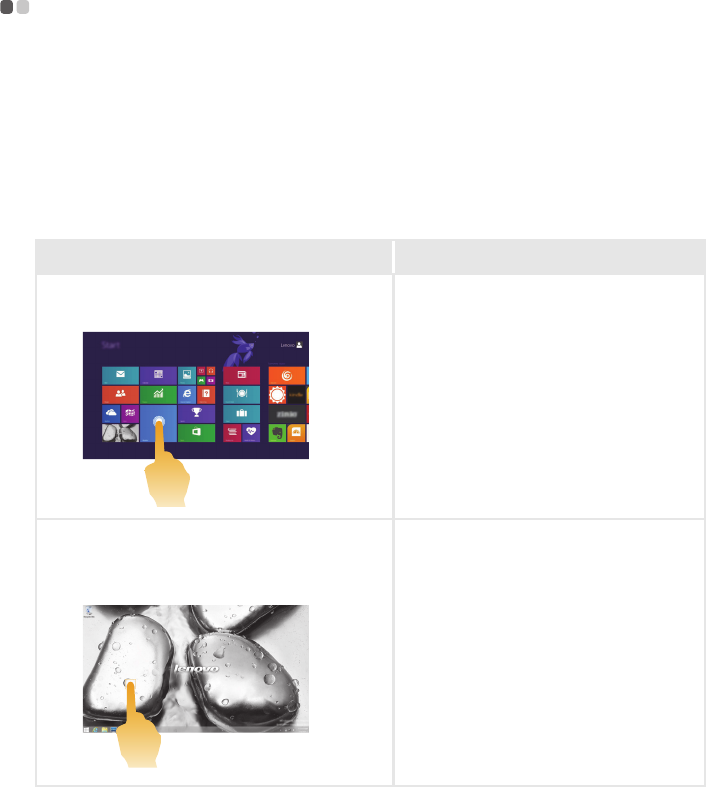
20
Chapter 2. Starting to use Windows 8.1
Touch screen operation - - - - - - - - - - - - - - - - - - - - - - - - - - - - - - - - - - - - - - - - - - - - - - - - - - - - - - - - - - - - - - - - - - - -
Thedisplaypanelcanacceptinputslikeatablet,usingthemulti‐touch
screen,orlikeatraditionalnotebookcomputer,usingthekeyboardand
touchpad.
Multi-touch gestures
Youcantouchthescreenwithoneormorefingertipstoperformavarietyof
tasks.
Frequently used gestures Tasks performed
Tap
Taponceonanitem.
Performsanaction,suchasstarting
anapp,openingalink,or
performingacommand.Similarto
left‐clickingwithamouse.
Press and hold
Pressyourfingerdownandleaveitthere
foramoment.
Allowsyoutoseedetailed
informationbeforeselectingan
action.Canalsoopenamenuwith
moreoptions.Similarto
right‐clickingwithamouse.
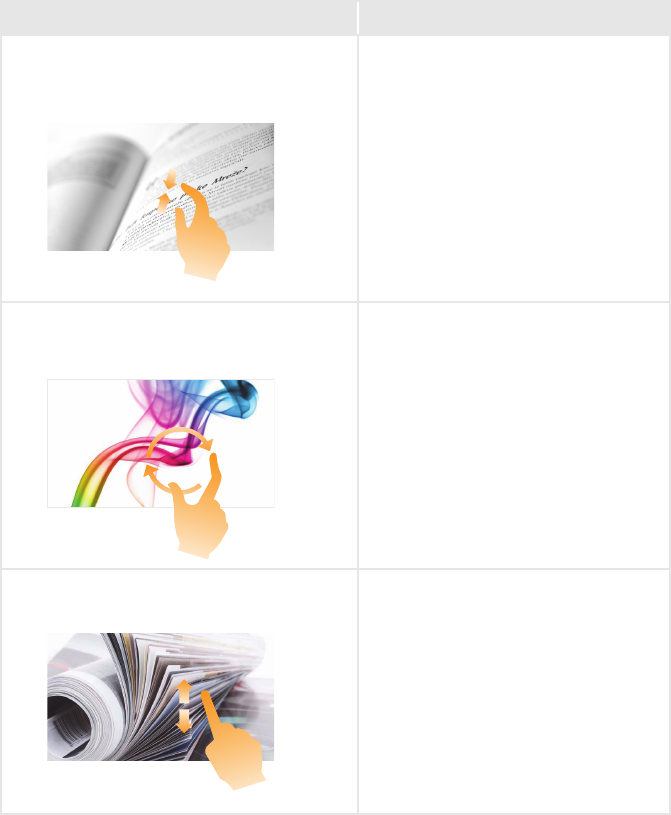
Chapter 2. Starting to use Windows 8.1
21
(continued)
Frequently used gestures Tasks performed
Zoom
Movetwofingerstogetherorapartwhile
touchingthescreen.
Zoomsinandoutonvisualapps,
suchaspicturesandmaps.Canalso
jumptothebeginningorendofalist.
Rotate
Placetwoormorefingersonanitemand
thenturnyourhand.
Turnsanobject.(Note:Notallitems
canberotated,dependinguponthe
app.)
Slide
Dragyourfingeracrossthescreen.
Pansorscrollsthroughlistsand
pages.Canalsomoveanobjectorbe
usedtodraworwrite,depending
upontheapp.Similartopressing
andholdingtopanandtoscrolling
withamouse.